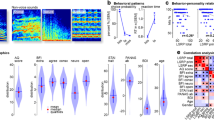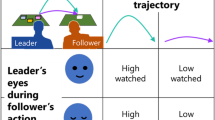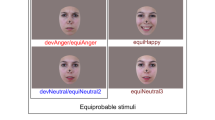Abstract
To examine mirror neuron abnormalities in autism, high-functioning children with autism and matched controls underwent fMRI while imitating and observing emotional expressions. Although both groups performed the tasks equally well, children with autism showed no mirror neuron activity in the inferior frontal gyrus (pars opercularis). Notably, activity in this area was inversely related to symptom severity in the social domain, suggesting that a dysfunctional 'mirror neuron system' may underlie the social deficits observed in autism.
This is a preview of subscription content, access via your institution
Access options
Subscribe to this journal
Receive 12 print issues and online access
$209.00 per year
only $17.42 per issue
Buy this article
- Purchase on Springer Link
- Instant access to full article PDF
Prices may be subject to local taxes which are calculated during checkout



Similar content being viewed by others
References
Williams, J.H., Whiten, A., Suddendorf, T. & Perrett, D.I. Neurosci. Biobehav. Rev. 25, 287–295 (2001).
Rizzolatti, G. & Craighero, L. Annu. Rev. Neurosci. 27, 169–192 (2004).
Iacoboni, M. et al. Science 286, 2526–2528 (1999).
Johnson-Frey, S.H. et al. Neuron 39, 1053–1058 (2003).
Iacoboni, M. in Perspectives on Imitation: From Neuroscience to Social Science (eds. Hurley, S. & Chater, N.) 77–99 (MIT Press, Cambridge, Massachusetts, 2005).
Carr, L. et al. Proc. Natl. Acad. Sci. USA 100, 5497–5502 (2003).
Leslie, K.R., Johnson-Frey, S.H. & Grafton, S.T. Neuroimage 21, 601–607 (2004).
Nishitani, N., Avikainen, S. & Hari, R. Ann. Neurol. 55, 558–562 (2004).
Oberman, L.M. et al. Brain Res. Cogn. Brain Res. 24, 190–198 (2005).
Theoret, H. et al. Curr. Biol. 15, R84–R85 (2005).
Lord, C. et al. J. Autism Dev. Disord. 30, 205–223 (2000).
Lord, C., Rutter, M. & Le Couteur, A. J. Autism Dev. Disord. 24, 659–685 (1994).
Dalton, K.M. et al. Nat. Neurosci. 8, 519–526 (2005).
Hadjikhani, N. et al. Neuroimage 22, 1141–1150 (2004).
Pierce, K., Haist, F., Sedaghat, F. & Courchesne, E. Brain 127, 2703–2716 (2004).
Acknowledgements
Support for this work was provided by a grant from the National Institute of Child Health and Human Development (P01 HD035470). The authors thank the Brain Mapping Medical Research Organization, the Brain Mapping Support Foundation, the Pierson-Lovelace Foundation, the Ahmanson Foundation, the Tamkin Foundation, the Jennifer Jones-Simon Foundation, the Capital Group Companies Charitable Foundation, the Robson Family, the William M. and Linda R. Dietel Philanthropic Fund at the Northern Piedmont Community Foundation, the Northstar Fund and the National Center for Research Resources (grants RR12169, RR13642 and RR08655).
Author information
Authors and Affiliations
Corresponding author
Ethics declarations
Competing interests
The authors declare no competing financial interests.
Supplementary information
Supplementary Fig. 1
Reliably greater activity in ASD children vs. typically developing children during imitation comprised right visual and left anterior parietal areas (thresholded at t > 1.83, P < 0.05, corrected for multiple comparisons at the cluster level). (PDF 64 kb)
Supplementary Fig. 2
Reliable signal increases during observation of facial emotional expressions in both typically developing (a) and ASD group (b) groups comprised the fusiform gyrus and the amygdala (thresholded at t > 1.83, P < 0.05, corrected for multiple comparisons at the cluster level; small volume correction for the amygdala). (PDF 77 kb)
Supplementary Table 1
Subject demographics for children participating in the fMRI study. (PDF 37 kb)
Supplementary Table 2
Subject demographics for subset of children participating in both fMRI and behavioral eye-tracking Sessions. (PDF 38 kb)
Supplementary Table 3
Peaks of activity during imitation of emotional expressions (PDF 64 kb)
Supplementary Table 4
Peaks of activity during observation of emotional expressions (PDF 53 kb)
Supplementary Table 5
Negative correlations between activity during imitation of emotional expressions and subjects' scores on the social subscales of the ADOS and ADI (PDF 51 kb)
Rights and permissions
About this article
Cite this article
Dapretto, M., Davies, M., Pfeifer, J. et al. Understanding emotions in others: mirror neuron dysfunction in children with autism spectrum disorders. Nat Neurosci 9, 28–30 (2006). https://doi.org/10.1038/nn1611
Received:
Accepted:
Published:
Issue Date:
DOI: https://doi.org/10.1038/nn1611
This article is cited by
-
Differences in Praxis Errors in Autism Spectrum Disorder Compared to Developmental Coordination Disorder
Journal of Autism and Developmental Disorders (2024)
-
Manipulating facial musculature with functional electrical stimulation as an intervention for major depressive disorder: a focused search of literature for a proposal
Journal of NeuroEngineering and Rehabilitation (2023)
-
Brain mechanisms of social signalling in live social interactions with autistic and neurotypical adults
Scientific Reports (2023)
-
Eye Gaze in Autism Spectrum Disorder: A Review of Neural Evidence for the Eye Avoidance Hypothesis
Journal of Autism and Developmental Disorders (2023)
-
Reading and reacting to faces, the effect of facial mimicry in improving facial emotion recognition in individuals with antisocial behavior and psychopathic traits
Current Psychology (2023)



